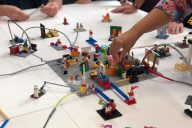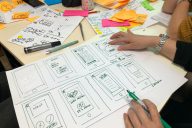Author is a design thinking enthusiast and a service designer, who has designed, organised or taken part in three different types of innovation events: Hackathons, Service Jams, and Design Sprints. These topics are covered in the subsequent parts of this series, they can be read in any order. Find the introduction post on Tikissä and the first part Service Jams on Tikissä.
So, you may have wondered what is the difference between a Hackathon, a Jam, and a Design Sprint? These words swirl around with an assumption that people know what they are and what the difference is. All three of these events are what I would call innovative learning by doing events. They all require a new way of thinking and working and they will all have the participants learning at an intense rate.
It used to be that Hackathons were thought to be only for hard core coders but as time has gone on, more participants with complimentary skills have been involved. My first job as an entrepreneur consultant was to organise an in-house hackathon for a software company of about 100 employees. This was used as a team day for anyone who wanted to take the day to focus on a personal project, either related to their work or something totally unrelated. It was amazing to introduce them to a few service design techniques that helped them keep the end user in mind.
So, let’s look at what HACKATHONS as an intensive learning by doing events can offer to participants.
When a hackathon is a Hackathon?
There are many events that people end up calling hackathons. Lots of times this is done for a few reasons:
- The person doesn’t really know what a hackathon is
- Hackathon is a very trendy word and it makes their event sound cool and edgy
- or, it is a hackathon or has some hackathon elements.
These are, of course, flexible to some degree and also Hackathons have become wider in scope but it is still centered around a technical solution.
The original hackathons are tech/coding related events where the goal is “to create functioning software or hardware by the end of the event.” Others have called hackathons an event where “a group of programmers work together on a collaborative project”. It is also acknowledged that “most hackathons are competitions where several teams are competing to create prototypes that innovate on a theme or improve upon an existing project.”
Hackathons are time-bound and themed events. And with this broad explanation, it is important to note that there are all different kinds of hackathons, just to mention few categories:
- internal
- open
- online
- offline
- one-off events
- extended, multi-phase events
So many of the outcomes will be determined by the other decisions that are made.
In open events, it is possible to have many different goals. A company may be sponsoring it and looking for specific fixes or developments. Multiple actors may be coming together to work on broader societal issues or industry-wide issues. There are so many goals of hackathons. It may even be based on a certain technology that the owners/creators want to test and see how external people/groups would use it.
If this will be an internal event within a company, then it is highly likely that this event will be based on a pressing business problem or it could be a staff event to get people out of their everyday groove. Depending on how the company wants to run it, it could be a one-day event that focuses teams on one specific problem or it could be a more open problem that they are looking for new ideas to define the issues.
How Hackathons work?
Hackathons are events that primarily take between 24 and 72 hours. This isn’t to say that there are no hackathons that are longer but most fall in the 24 to 72-hour time frame. This 1-3-day timeframe is the framework for the intense process that defines hackathons and other intense learning experiences.
What are the outcomes?
Just as there are many versions of what a hackathon is, but most commonly, the outcome of a hackathon is an MVP of a product/service technical in nature, networking with other people with their or complementary skills and with the hackathon organisers and other stakeholders, there are also learning outcomes whether those are rapid prototyping methods or team-working skills (or others).
How teams are created?
There are two ways to attend: some have individuals join and form teams on the first day and some as people to join as a team. An extension of the team is the solution. Sometimes it will be a pre-requisite to submit a first draft of your team’s idea. Therefore, it is more of an application to join the Hackathon rather than just attending one.
What skills are needed?
In a more typical hackathon, there will be a need for technical skills. Both frontend and backend development skills are very useful…but it doesn’t stop there. It is also advisable to have other skills on your team such as design skills, project management skills, user experience skills, et cetera.
What makes great hackathon teams?
The best kinds of teams are diverse ones. Diverse in life experiences, diverse in backgrounds, and as mentioned above, diverse in skills. It is also good that everyone is there to learn and have fun.
What connections are made?
The variety and depth of connections you will make at a hackathon will depend on many factors, such as if you join with a team already or form one on the first day. The ability to connect with others can also be affected by the schedule. For example, it may be easier to make connections if there are social moments or events as part of the schedule.
Where would you find a hackathon?
If you have a big company sponsor who has a particular problem to fix, especially something that is related to the tech, then a Hackathon is probably the way to go. There is a lot of information out there. You can quite easily find out how to set one up. Finding the information is easy, actual execution may not be so easy. So, reach out to the HXRC team and ask them if they know of any events taking place either internally or externally that you can check out.
Author
Pamela Spokes works as a Service Designer in Metropolia’s RDI team. Originally from Canada, Pamela has years of experience in university admin focusing on international recruitment, marketing, and the international student/staff experience. With a Bachelor’s from Canada, a Master’s degree from Sweden, an MBA in Service Innovation & Design from Laurea, and her AmO from Haaga-Helia, she is interested in purposefully designed experiences that are centred around the user. Don’t be surprised if she knocks on your door to talk about learning co-creation methods through intensive learning experiences.
- Are you wanting to teach or learn these skills? Could you use this in a project or a course that you are a part of? You can reach out and ask for advice. I am happy to hear from you!









Ei kommentteja